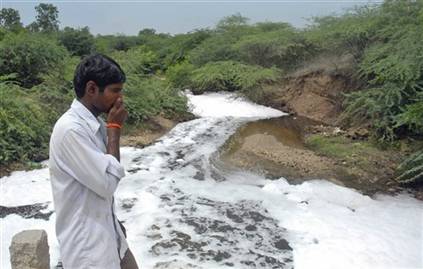 [Image: The Iska Vagu stream near Hyderabad, India. "Indian factories that make lifesaving drugs swallowed by millions worldwide are creating the worst pharmaceutical pollution ever measured,"we read, "spewing enough of one antibiotic into a stream each day to treat everyone living in Sweden for a work week." Photo by AP Photo/Mahesh Kumar A].
[Image: The Iska Vagu stream near Hyderabad, India. "Indian factories that make lifesaving drugs swallowed by millions worldwide are creating the worst pharmaceutical pollution ever measured,"we read, "spewing enough of one antibiotic into a stream each day to treat everyone living in Sweden for a work week." Photo by AP Photo/Mahesh Kumar A]."If you just swallow a few gasps of water," a German doctor said to MSNBC, "you're treated for everything. The question is for how long?"
Indeed, all of this has the unsurprising effect that "some of India's poor are unwittingly consuming an array of chemicals that may be harmful, and could lead to the proliferation of drug-resistant bacteria." For instance, amongst this mix are high levels of Ciproflaxin:
- The more bacteria is exposed to a drug, the more likely that bacteria will mutate in a way that renders the drug ineffective. Such resistant bacteria can then possibly infect others who spread the bugs as they travel. Ciprofloxacin was once considered a powerful antibiotic of last resort, used to treat especially tenacious infections. But in recent years many bacteria have developed resistance to the drug, leaving it significantly less effective.
Aside from the very real health implications of this story, though, I'm fascinated by these drugs' effect on the landscape; in other words, millions of pounds' worth of loose pharmaceuticals will surely someday form a detectable layer in the soil, given time.
Pharmaco-geological formations take shape in the sand, compacted into strange new types of stone. The locals dissolve slices of it in their tea, as it's used to treat illnesses.
Thousands of years pass; then millions. The rocks you're looking at in the wall of that canyon are made of lithified Prozac. Tylenol Gorge State Park.
A deltaic geography of sedimentary Tamiflu is eventually mined as a building material; temples of this unusually smooth rock are built; visits to them are believed to help prevent infection.
And how will this affect plants? If river grasses and trees begin to accumulate this novel class of mineral, taking pharmaceutical-rich waters up into their roots, will it change the way they grow? Day of the Triffids.
"We don't have any other source, so we're drinking it," a local woman named R. Durgamma explains to MSNBC. In a particularly chilling detail that reveals how those in power clearly know what is happening there, she adds: "When the local leaders come, we offer them water and they won't take it."










